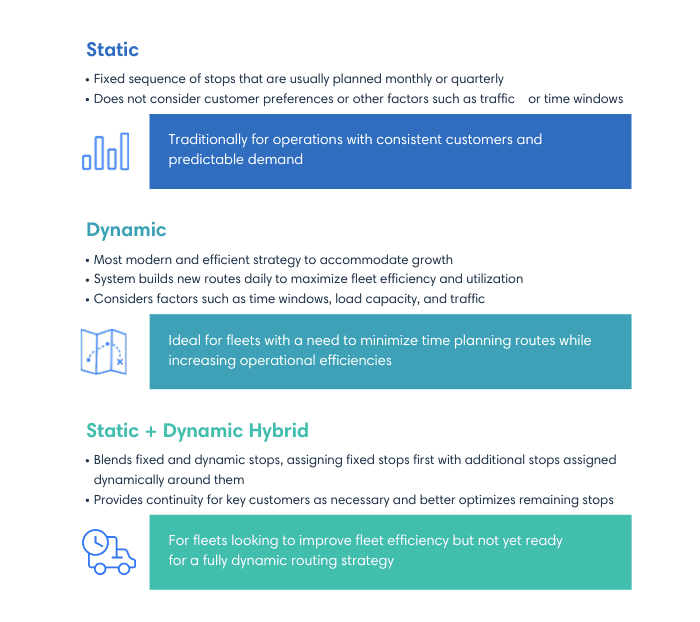
Dynamic Routing | The Good, The Bad, The Ugly

Wise Systems
Dynamic Routing | The Good, The Bad, The Ugly

Wise Systems

Dynamic routing is one of the newest innovations in the last-mile space and, if you believe the hype, everyone’s doing it. However, the reality on the ground is quite different. Many teams are interested in the possibilities that dynamic routing holds but approach the topic with caution. Understandably.
The truth? Dynamic routing can have immense benefits for your company, in both efficiency and fleet utilization, but only if it’s the right solution for your business.
Borrowing from the eponymous Clint Eastwood movie, let’s break dynamic routing into three buckets — the good, the bad, and the ugly. Then, we’ll review how other technologies and tools can be integrated with dynamic routing and what innovations are on the horizon.
But first, let’s align on what, exactly, we mean by dynamic routing.
In this article:
- What is Dynamic Routing?
- The Good – The Benefits of Dynamic Routing
- The Bad – The Shortfalls of Dynamic Routing
- The Ugly – Consequences of Moving to Dynamic Routing Before You’re Ready
- Frequently Asked Questions
What is Dynamic Routing?

Using machine learning and artificial intelligence (AI) within modern route optimization software, dynamic routing instantly calculates highly complex routes with multiple constraints (time windows, traffic, load capacity, driver shift times/availability). For most organizations, dynamic routes are built daily with the understanding that there will not likely be many similarities between routes from day to day or week to week.
The opposite of dynamic routing is static routing, defined as manually configured routes based on fixed data that are planned periodically, typically monthly or quarterly. Static routing doesn’t consider factors such as traffic or weather conditions.
Instead, drivers receive a new route plan each day based on the orders in the system at that time. Given the number of orders and variables, dynamic routing is typically far beyond the capacity of human dispatchers.

Discover how to leverage Route Planner from Wise Systems to optimize routing and improve your fleet’s efficiency. Book a demo today!
The Good – The Benefits of Dynamic Routing

When routing dynamically, your drivers receive new routes daily rather than following a fixed schedule day after day. At its essence, dynamic routing is the ultimate strategy for balancing the needs of the fleet with the needs of the customer. When implemented correctly, the benefits are massive.
Improved fleet utilization
By considering constraints like load capacity, dynamic routing algorithms ensure that each truck is being used to its full potential. Dynamic routing minimizes “empty miles” by using data and algorithms to identify the most efficient routes and schedules for deliveries, reducing the amount of time fleet vehicles spend on the road without a load.
Reduced fleet mileage
Dynamic routing minimizes the number of vehicles on the road and looks for the most efficient order of stops, reducing overall fleet mileage. It takes into account factors such as traffic conditions, weather, road closures, and delivery schedules to create the most efficient route for each vehicle.
By avoiding traffic congestion and choosing the shortest path to each destination, companies can reduce the distance traveled by each vehicle, ultimately leading to lower fuel consumption and reduced wear and tear on vehicles.
Reduced driver hours
In addition to adjusting for driver shift times and driver availability, with dynamic routing, you can help your drivers avoid traffic jams and round-about routes. Instead of using fixed routes that may not account for traffic patterns, weather conditions, or other unforeseen obstacles, dynamic routing software can adjust routes on the fly to account for these factors. This means that drivers spend less time driving long distances and making unnecessary detours, ultimately reducing their overall hours on the road.
Additionally, dynamic routing can help companies improve delivery scheduling and coordination. By optimizing routes based on real-time data, companies can ensure that drivers are assigned to the most efficient routes possible. This can help reduce the amount of time drivers spend waiting at stops or dealing with inefficient schedules, leading to a reduction in driver hours.
Increase in on-time deliveries

Clients using dynamic routing see a higher number of on-time deliveries due to real-time updates to routes, which reduces unnecessary travel time and eliminates inefficient routes. By constantly analyzing and adjusting routes based on real-time data, companies can ensure that drivers are taking the most direct and efficient paths to their destinations.
Various factors, such as traffic conditions, vehicle capacities, delivery windows, and pick-up locations, can often lead to delays if not addressed promptly. Dynamic routing considers all of these factors when creating the most efficient delivery routes, allowing companies to adapt to unexpected changes and challenges that may arise during the delivery process to avoid delays.
In addition, dynamic routing can help companies identify underutilized vehicles or routes. This makes it possible to make adjustments to ensure that resources are being used most effectively, ultimately leading to faster delivery times and improved on-time performance.
More accurate ETAs
Dynamic routing also allows companies to communicate more effectively with customers about delivery times. Since routes are monitored and updated continuously, dynamic routing allows you to provide more accurate ETAs to your customers.
Providing customers with accurate, real-time updates on the status of their deliveries means they’re more likely to be prepared and available to receive their orders. This reduces the likelihood of missed deliveries and the need for re-delivery attempts.
Provide more accurate ETAs and increase on-time deliveries with the Wise Systems delivery automation platform. Request a demo today to learn more!
Reduced maintenance costs
Dynamic routing reduces maintenance costs by minimizing wear and tear on vehicles. By avoiding unnecessary stops, reducing idling time, and optimizing the most efficient routes, vehicles experience less strain on their engines, brakes, and other components. This can lead to fewer breakdowns, less frequent maintenance needs, and ultimately lower costs for repairs and replacements.
Additionally, dynamic routing can help businesses plan more efficiently for maintenance schedules. By tracking vehicle usage and performance data, companies can better predict when routine maintenance tasks, such as oil changes or tire rotations, need to be performed. This proactive approach can prevent costly breakdowns and damage by addressing maintenance needs before they become major issues.
Reduced fuel costs
Traditional static routes often do not account for factors such as traffic, weather conditions, or road closures, which can result in vehicles traveling longer distances than necessary. In contrast, dynamic routing continuously updates and adjusts routes based on these factors, ensuring that drivers are taking the most efficient path to their destination.
Additionally, dynamic routing can help reduce idle time, which is a major contributor to fuel consumption. By providing drivers with real-time updates on traffic conditions and suggesting alternative routes, dynamic routing can help them avoid getting stuck in traffic jams or waiting at long stoplights. This means less time spent idling and more time spent moving, ultimately leading to fuel savings.
Dynamic routing can also optimize the sequencing of stops on a driver’s route, helping to reduce overall mileage and fuel consumption. By analyzing factors such as delivery windows, customer locations, and traffic patterns, dynamic routing can determine the most efficient order in which to make stops, minimizing backtracking and unnecessary driving.
Reduced environmental impact
Anheuser-Busch continues to invest in a sustainable future for its fleet operations. Read more here: https://t.co/v3pqA57AkA
— Wise Systems (@goWiseSystems) April 19, 2023
Dynamic routing helps to reduce environmental impact by minimizing the distance traveled by vehicles. It analyzes traffic patterns, weather conditions, and other factors to identify the most efficient routes, which decreases fuel consumption and reduces emissions.
Additionally, dynamic routing can help companies avoid congested areas and high-traffic areas, further cutting down on fuel consumption and emissions. As discussed above, dynamic routing can also help to minimize idle time, another factor that contributes to increased fuel consumption and emissions. By rerouting vehicles in real-time based on changing conditions, companies can ensure that their vehicles are operating at maximum efficiency and minimizing their environmental impact.
Book a demo today to discover how the Wise Systems delivery automation platform, with its comprehensive solution for every stage of the delivery process, can help you realize these benefits and more.
The Bad – The Shortfalls of Dynamic Routing

As with many technologies or strategies, dynamic routing is touted as “disruptive.” It’s definitely different, especially if you’re coming from decades of static routing.
The question is whether your business is a fit for dynamic routing in the first place. If there’s variability in your customers’ orders, dynamic routing is worth considering. If, however, you have fixed orders on fixed days with very little variation, dynamic routing may not be a fit for your business model.
Dynamic routing can also be costly to implement and maintain. Investing in the necessary technology and software to support dynamic routing can be expensive, not to mention the ongoing costs of training and technical support. For some fleet operators, the cost of implementing dynamic routing may outweigh the potential benefits.
Additionally, integrating dynamic routing systems with existing fleet management systems and other operational tools can be complex and time-consuming. Drivers accustomed to traditional routing methods may resist the changes introduced by dynamic routing systems, as there may be a steep learning curve for drivers and fleet managers when adapting to new technologies and processes.
The Ugly – Consequences of Moving to Dynamic Routing Before You’re Ready

For an effective shift to a dynamic operation, keep a few things in mind:
- Preparation is key for a successful shift in your routing process. This includes your team and your customers, so build that into your plan.
- Ensure system compatibility. Verify that your existing infrastructure is compatible with the new dynamic routing system. Incompatibility can cause delays and disruptions. You should also ensure that you have robust IT support to handle any technical issues that may arise during implementation.
- Choose scalable technologies. Ensure that the dynamic routing system you choose can scale with your business growth. Implementing a system that cannot handle future demand can be counterproductive and necessitate additional technology investments in the future. Choose flexible solutions that can be adjusted as your routing needs evolve.
- Ensure all team members receive comprehensive training on the new system. Lack of proper training can lead to confusion, errors, and inefficiencies. Provide continuous support and resources to help employees adapt to the new routing process.
- Consider a phased implementation. Plan the transition to minimize disruptions to daily operations. A poorly executed transition can lead to missed deliveries and unhappy customers. A phased implementation gradually introduces dynamic routing, allowing your team to adapt incrementally.
- Data availability and accuracy are crucial. Ensure that you have reliable data sources for traffic, weather, and other variables. Inaccurate data can lead to suboptimal routing decisions. Seamless integration of data from various sources is essential for the system to function effectively.
- Order cutoff times become more critical. Your routes will be planned daily, meaning there’s little flexibility in order cutoff times.
- Vehicles for routes aren’t assigned until the routes are built each night. This means that vehicles can only be packed once the route is built. Consider the timeline implications for picking and packing.
- Cross-team communication is key to success. This includes communication with drivers, warehouse operators, and routing and dispatch teams.
When integrations are well built and well implemented, they enhance and streamline the last-mile delivery process. Check out our latest blog on Wise Systems Connect and our growing partner ecosystem here! https://t.co/3At4la667o pic.twitter.com/jM9jV6b77v
— Wise Systems (@goWiseSystems) April 11, 2023
Dynamic routing is a phenomenal solution for many businesses with the power to bring incredible savings and efficiencies for organizations in industries where it makes sense.
And, if that’s the direction you’re headed, keep in mind that a gradual transition, involving a hybrid static + dynamic solution could be the perfect onramp, providing a balance of flexibility and reliability. If you’re looking for a good place to start, take a look at our Choosing the Right Routing Strategy for Your Fleet White Paper.
The Wise Systems delivery automation platform offers a comprehensive suite of solutions for every stage of the delivery process. Book a demo today to discover how Wise Systems can help you optimize your delivery operations.
Frequently Asked Questions
Is dynamic routing suitable for all types of fleets?
Dynamic routing is highly versatile and can be suitable for various types of fleets, from small local delivery vehicles to large-scale logistics operations. However, its suitability depends on the nature of the fleet’s operations.
Fleets with variable schedules, fluctuating demand, or frequent last-minute changes benefit the most from dynamic routing. Conversely, fleets with highly predictable and unchanging schedules might not see as significant an advantage.
Can dynamic routing help reduce operational costs?
Yes, dynamic routing can significantly reduce operational costs. By optimizing routes in real-time, it minimizes travel distances and time, leading to lower fuel consumption and vehicle wear and tear. Additionally, it can improve the efficiency of deliveries and pickups, reducing the need for overtime and maximizing the use of resources. This all contributes to substantial cost savings over time.
How can I measure the effectiveness of a dynamic routing system?
Several key performance indicators (KPIs) can be used to measure the effectiveness of a dynamic routing system. Important KPIs to monitor include delivery time accuracy, fuel consumption, total distance traveled, vehicle utilization rates, and customer satisfaction levels.
Additionally, tracking metrics such as the number of late or missed deliveries and the frequency of route adjustments can provide insights into the system’s performance and areas for improvement.
What technologies are used in dynamic routing?
Technologies used in dynamic routing include GPS tracking, real-time traffic monitoring systems, and advanced algorithms that process and analyze large amounts of data to optimize routes. Additionally, mobile apps for drivers, cloud-based software platforms, and machine learning tools are commonly used to enhance the flexibility and accuracy of dynamic routing systems.
What data is required for effective dynamic routing?
Effective dynamic routing requires various data, including real-time traffic conditions, delivery or service locations, delivery time windows, vehicle capacity, and driver availability. Historical data on travel times, customer preferences, and typical traffic patterns can also enhance the accuracy and efficiency of the routing algorithms.





